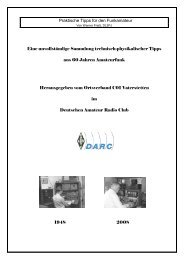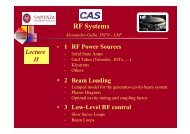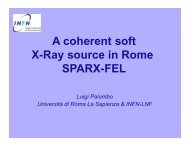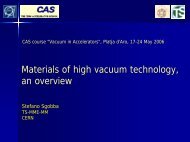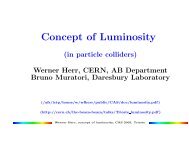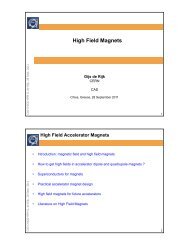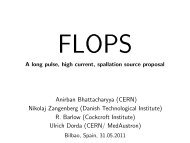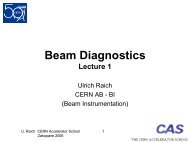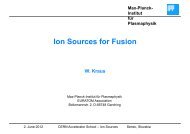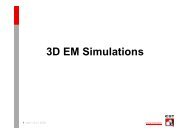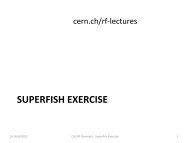Basic_concepts_CAS_Chios_2011_Caspers_Kowina version 8 ...
Basic_concepts_CAS_Chios_2011_Caspers_Kowina version 8 ...
Basic_concepts_CAS_Chios_2011_Caspers_Kowina version 8 ...
You also want an ePaper? Increase the reach of your titles
YUMPU automatically turns print PDFs into web optimized ePapers that Google loves.
RF <strong>Basic</strong> Concepts<br />
Fritz <strong>Caspers</strong>, Piotr <strong>Kowina</strong><br />
Intermediate Level Accelerator Physics,<br />
<strong>Chios</strong>, Greece, September <strong>2011</strong>
<strong>CAS</strong>, CHIOS, September <strong>2011</strong><br />
Contents<br />
RF measurement methods – some history and overview<br />
Superheterodyne Concept and its application<br />
Voltage Standing Wave Ratio (VSWR)<br />
Introduction to Scattering-parameters (S-parameters)<br />
Properties of the S matrix of an N-port (N=1…4) and<br />
examples<br />
Smith Chart and its applications<br />
Appendices<br />
RF <strong>Basic</strong> Concepts, <strong>Caspers</strong>, <strong>Kowina</strong>
<strong>CAS</strong>, CHIOS, September <strong>2011</strong><br />
Measurement methods - overview (1)<br />
There are many ways to observe RF signals. Here we give a brief<br />
overview of the five main tools we have at hand<br />
Oscilloscope: to observe signals in time domain<br />
periodic signals<br />
burst signal<br />
application: direct observation of signal from a pick-up, shape of<br />
common 230 V mains supply voltage, etc.<br />
Spectrum analyzer: to observe signals in frequency domain<br />
sweeps through a given frequency range point by point<br />
application: observation of spectrum from the beam or of the spectrum<br />
emitted from an antenna, etc.<br />
RF <strong>Basic</strong> Concepts, <strong>Caspers</strong>, <strong>Kowina</strong>
<strong>CAS</strong>, CHIOS, September <strong>2011</strong><br />
Measurement methods - overview (2)<br />
Dynamic signal analyzer (FFT analyzer)<br />
Acquires signal in time domain by fast sampling<br />
Further numerical treatment in digital signal processors (DSPs)<br />
Spectrum calculated using Fast Fourier Transform (FFT)<br />
Combines features of a scope and a spectrum analyzer: signals can be<br />
looked at directly in time domain or in frequency domain<br />
Contrary to the SPA, also the spectrum of non-repetitive signals and<br />
transients can be observed<br />
Application: Observation of tune sidebands, transient behavior of a phase<br />
locked loop, etc.<br />
Coaxial measurement line<br />
old fashion method – no more in use but good for understanding of<br />
concept<br />
Network analyzer<br />
Excites a network (circuit, antenna, amplifier or similar) at a given CW<br />
frequency and measures response in magnitude and phase => determines<br />
S-parameters<br />
Covers a frequency range by measuring step-by-step at subsequent<br />
frequency points<br />
Application: characterization of passive and active components, time domain<br />
reflectometry by Fourier transforming reflection response, etc.<br />
RF <strong>Basic</strong> Concepts, <strong>Caspers</strong>, <strong>Kowina</strong>
<strong>CAS</strong>, CHIOS, September <strong>2011</strong><br />
Superheterodyne Concept (1)<br />
Design and its evolution<br />
The diagram below shows the basic elements of a single con<strong>version</strong> superhet receiver. The<br />
essential elements of a local oscillator and a mixer followed by a fixed-tuned filter and IF amplifier<br />
are common to all superhet circuits. [super ετερω δυναµισ] a mixture of latin and greek … it<br />
means: another force becomes superimposed.<br />
This type of configuration we find in any<br />
conventional (= not digital) AM or FM<br />
radio receiver.<br />
The advantage to this method is that most of the radio's signal path has to be sensitive to only a<br />
narrow range of frequencies. Only the front end (the part before the frequency converter stage)<br />
needs to be sensitive to a wide frequency range. For example, the front end might need to be<br />
sensitive to 1–30 MHz, while the rest of the radio might need to be sensitive only to 455 kHz, a<br />
typical IF. Only one or two tuned stages need to be adjusted to track over the tuning range of the<br />
receiver; all the intermediate-frequency stages operate at a fixed frequency which need not be<br />
adjusted.<br />
en.wikipedia.org<br />
RF <strong>Basic</strong> Concepts, <strong>Caspers</strong>, <strong>Kowina</strong>
<strong>CAS</strong>, CHIOS, September <strong>2011</strong><br />
Superheterodyne Concept (2)<br />
RF Amplifier = wideband front end amplification (RF = radio frequency)<br />
The Mixer can be seen as an analog multiplier which multiplies the RF signal with the LO (local<br />
oscillator) signal.<br />
The local oscillator has its name because it’s an oscillator situated in the receiver locally and<br />
not as far away as the radio transmitter to be received.<br />
IF stands for intermediate frequency.<br />
IF<br />
The demodulator can be an amplitude modulation (AM) demodulator (envelope detector) or a<br />
frequency modulation (FM) demodulator, implemented e.g. as a PLL (phase locked loop).<br />
The tuning of a normal radio receiver is done by changing the frequency of the LO, not of the IF<br />
filter.<br />
RF <strong>Basic</strong> Concepts, <strong>Caspers</strong>, <strong>Kowina</strong><br />
en.wikipedia.org
Example for Application of the<br />
Superheterodyne Concept in a Spectrum<br />
Analyzer<br />
Agilent, ‘Spectrum Analyzer <strong>Basic</strong>s,’<br />
Application Note 150, page 10 f.<br />
<strong>CAS</strong>, CHIOS, September <strong>2011</strong><br />
The center frequency is fixed, but<br />
the bandwidth of the<br />
IF filter can be modified.<br />
RF <strong>Basic</strong> Concepts, <strong>Caspers</strong>, <strong>Kowina</strong><br />
The video filter is a simple lowpass<br />
with variable bandwidth<br />
before the signal arrives to the<br />
vertical deflection plates of the<br />
cathode ray tube.
Another basic measurement example<br />
30 cm long concentric cable with<br />
vacuum or air between conductors<br />
(e r =1) and with characteristic<br />
impedance Z c = 50 Ω.<br />
An RF generator with 50 Ω source<br />
impedance Z G is connected at one<br />
side of this line.<br />
Other side terminated with load<br />
impedance: ¡and ZL =50 Ω; 0 Ω<br />
Oscilloscope with high impedance<br />
probe connected<br />
at port 1<br />
Scope<br />
<strong>CAS</strong>, CHIOS, September <strong>2011</strong><br />
Z in >1MΩ<br />
Z G =50Ω<br />
∼<br />
RF <strong>Basic</strong> Concepts, <strong>Caspers</strong>, <strong>Kowina</strong><br />
Z L
Measurements in time domain using Oscilloscope<br />
Z in =1MΩ<br />
ZG =50Ω<br />
∼<br />
matched case: Z L =Z G<br />
no reflection<br />
<strong>CAS</strong>, CHIOS, September <strong>2011</strong><br />
Z L<br />
RF <strong>Basic</strong> Concepts, <strong>Caspers</strong>, <strong>Kowina</strong><br />
2ns<br />
open: Z L =∞Ω<br />
total reflection; reflected signal<br />
in phase, delay 2x1 ns.<br />
original signal reflected signal<br />
short: Z L =0 Ω<br />
total reflection; reflected signal<br />
in contra phase
How good is actually our termination?<br />
matched case:<br />
pure traveling wave<br />
<strong>CAS</strong>, CHIOS, September <strong>2011</strong><br />
f=0.25 GHz<br />
λ/4=30cm<br />
Caution: the colour coding corresponds to<br />
the radial electric field strength –<br />
these are not scalar equipotential<br />
lines which are anyway not defined<br />
for time dependent fields<br />
open<br />
short<br />
RF <strong>Basic</strong> Concepts, <strong>Caspers</strong>, <strong>Kowina</strong><br />
standing wave<br />
f=1 GHz<br />
λ=30cm<br />
f=1 GHz<br />
λ=30cm<br />
The patterns for the short and open case are equal; only the phase is<br />
opposite which correspond to different position of nodes.<br />
In case of perfect matching: traveling wave only. Otherwise mixture of<br />
traveling and standing waves.<br />
10
<strong>CAS</strong>, CHIOS, September <strong>2011</strong><br />
Voltage Standing Wave Ratio (1)<br />
Origin of the term “VOLTAGE Standing Wave Ratio – VSWR”:<br />
In the old days when there were no Vector Network Analyzers available, the reflection<br />
coefficient of some DUT (device under test) was determined with the coaxial<br />
measurement line.<br />
Coaxial measurement line: coaxial line with a narrow slot (slit) in length direction. In<br />
this slit a small voltage probe connected to a crystal detector (detector diode) is<br />
moved along the line. By measuring the ratio between the maximum and the minimum<br />
voltage seen by the probe and the recording the position of the maxima and minima<br />
the reflection coefficient of the DUT at the end of the line can be determined.<br />
RF source<br />
f=const.<br />
RF <strong>Basic</strong> Concepts, <strong>Caspers</strong>, <strong>Kowina</strong><br />
Cross-section of the coaxial<br />
measurement line<br />
Voltage probe weakly<br />
coupled to the radial<br />
electric field.<br />
11
<strong>CAS</strong>, CHIOS, September <strong>2011</strong><br />
Voltage Standing Wave Ratio (2)<br />
VOLTAGE DISTRIBUTION ON LOSSLESS TRANSMISSION LINES<br />
For an ideally terminated line the magnitude of voltage and current are constant along<br />
the line, their phase vary linearly.<br />
In presence of a notable load reflection the voltage and current distribution along a<br />
transmission line are no longer uniform but exhibit characteristic ripples. The phase<br />
pattern resembles more and more to a staircase rather than a ramp.<br />
A frequently used term is the “Voltage Standing Wave Ratio VSWR” that gives the ratio<br />
between maximum and minimum voltage along the line. It is related to load reflection<br />
by the expression<br />
V<br />
V<br />
max<br />
min<br />
=<br />
=<br />
a<br />
a<br />
+<br />
−<br />
b<br />
b<br />
VSWR<br />
Remember: the reflection coefficient Γ is defined via the ELECTRIC FIELD of the<br />
incident and reflected wave. This is historically related to the measurement method<br />
described here. We know that an open has a reflection coefficient of Γ=+1 and the<br />
short of Γ=-1. When referring to the magnetic field it would be just opposite.<br />
RF <strong>Basic</strong> Concepts, <strong>Caspers</strong>, <strong>Kowina</strong><br />
=<br />
V<br />
V<br />
max<br />
min<br />
=<br />
a<br />
a<br />
+<br />
−<br />
b<br />
b<br />
1+<br />
Γ<br />
=<br />
1−<br />
Γ<br />
12
<strong>CAS</strong>, CHIOS, September <strong>2011</strong><br />
Voltage Standing Wave Ratio (3)<br />
Γ VSWR Refl. Power |-Γ| 2<br />
0.0 1.00 1.00<br />
0.1 1.22 0.99<br />
0.2 1.50 0.96<br />
0.3 1.87 0.91<br />
0.4 2.33 0.84<br />
0.5 3.00 0.75<br />
0.6 4.00 0.64<br />
0.7 5.67 0.51<br />
0.8 9.00 0.36<br />
0.9 19 0.19<br />
1.0 ∞ 0.00<br />
With a simple detector diode we cannot measure the<br />
phase, only the amplitude.<br />
Why? – What would be required to measure the phase?<br />
Answer: Because there is no reference. With a mixer<br />
which can be used as a phase detector when<br />
connected to a reference this would be possible.<br />
maximum voltage over time<br />
π<br />
2<br />
phase<br />
− π<br />
2<br />
1.5<br />
0.5<br />
RF <strong>Basic</strong> Concepts, <strong>Caspers</strong>, <strong>Kowina</strong><br />
2<br />
1<br />
-pi/2<br />
0<br />
0 0.2 0.4 0.6 0.8 1<br />
x/λ<br />
pi/2<br />
0<br />
0 0.2 0.4 0.6 0.8 1<br />
x/λ<br />
13
<strong>CAS</strong>, CHIOS, September <strong>2011</strong><br />
S-parameters parameters- introduction (1)<br />
Look at the windows of this car:<br />
part of the light incident on the windows<br />
is reflected<br />
the rest is transmitted<br />
The optical reflection and transmission<br />
coefficients characterize amounts of<br />
transmitted and reflected light.<br />
Correspondingly: S-parameters<br />
characterize reflection and transmission<br />
of voltage waves through n-port<br />
electrical network<br />
Caution: in the microwave world<br />
reflection coefficients are expressed in<br />
terms of voltage ratio whereas in optics<br />
in terms of power ratio.<br />
RF <strong>Basic</strong> Concepts, <strong>Caspers</strong>, <strong>Kowina</strong><br />
14
<strong>CAS</strong>, CHIOS, September <strong>2011</strong><br />
S-parameters parameters- introduction (2) (<br />
When the linear dimmensions of an object approche one tenth of the (free<br />
space) wavelength this circuit can not be modeled precisely anymore with the<br />
single lumped element.<br />
Kurokawa in 1965 introduced „power waves” instead of voltage and current<br />
waves used so far K. Kurokawa, ‘Power Waves and the Scattering Matrix,’<br />
IEEE Transactions on Microwave Theory and Techniques,<br />
Vol. MTT-13, No. 2, March, 1965.<br />
The essencial difference between power wave and current wave is a<br />
normalisation to square root of characteristic impedance √Z c<br />
The abbreviation S has been derived from the word scattering.<br />
Since S-parameters are defined based on traveling waves<br />
-> the absolute value (modulus) does not vary along a lossless transmissions<br />
line<br />
-> they can be measured on a DUT (Device Under Test) situated at some<br />
distance from an S-parameter measurement instrument (like Network Analyser)<br />
How are the S-parameters defined?<br />
RF <strong>Basic</strong> Concepts, <strong>Caspers</strong>, <strong>Kowina</strong><br />
15
Simple example: example:<br />
a generator with a load<br />
Voltage divider:<br />
This is the matched case i.e. Z G = Z L .<br />
-> forward traveling wave only, no reflected wave.<br />
Amplitude of the forward traveling wave in this case is V1 =5V;<br />
forward power = 25V / 50 0.<br />
5W<br />
2<br />
Ω =<br />
Matching means maximum power transfer from a generator with<br />
given source impedance to an external load<br />
<strong>CAS</strong>, CHIOS, September <strong>2011</strong><br />
V<br />
V(t) = V 0 sin(ωt)<br />
V 0 = 10 V<br />
1<br />
= V<br />
0<br />
Z<br />
L<br />
ZL<br />
+ Z<br />
~<br />
= 5V<br />
RF <strong>Basic</strong> Concepts, <strong>Caspers</strong>, <strong>Kowina</strong><br />
G<br />
a 1<br />
Z G = 50Ω 1<br />
b 1<br />
V 1<br />
I 1<br />
1’ reference plane<br />
Z L = 50Ω<br />
(load<br />
impedance)<br />
16
(*see Kurokawa paper):<br />
a<br />
`1<br />
V1<br />
+<br />
=<br />
2<br />
Z<br />
Z<br />
Definition of power waves:<br />
<strong>CAS</strong>, CHIOS, September <strong>2011</strong><br />
I<br />
c<br />
V1<br />
− I1Zc<br />
b`1<br />
= ,<br />
2 Z c<br />
where the characteristic<br />
impedance<br />
1<br />
Z<br />
c<br />
c<br />
,<br />
=<br />
Power waves definition (1)<br />
Z<br />
G<br />
V(t) = V 0 sin(ωt)<br />
V 0 = 10 V<br />
a 1 is the wave incident to the terminating one-port (Z L )<br />
b 1 is the wave running out of the terminating one-port<br />
a 1 has a peak amplitude of 5V / √50Ω; voltage wave would be just 5V.<br />
What is the amplitude of b 1 ? Answer: b 1 = 0.<br />
Dimension: [V/√Z], in contrast to voltage or current waves<br />
Caution! US notation: power = |a| 2 whereas European notation (often): power = |a| 2 /2<br />
~<br />
Z G = 50Ω 1<br />
RF <strong>Basic</strong> Concepts, <strong>Caspers</strong>, <strong>Kowina</strong><br />
a 1<br />
b 1<br />
V 1<br />
I 1<br />
1’ reference plane<br />
Z L = 50Ω<br />
(load<br />
impedance)<br />
17
a<br />
b<br />
a<br />
b<br />
I1 V1<br />
+ I1Zc<br />
= ,<br />
V(t) = V0sin(ωt) `1 2 Z<br />
~<br />
b1 V V Z<br />
c<br />
L = 50Ω<br />
0 = 10 V<br />
1<br />
(load<br />
V1<br />
− I1Z<br />
impedance)<br />
c<br />
`1<br />
= , with<br />
Zc<br />
= ZG<br />
2 Z c<br />
`1<br />
`1<br />
More practical method for determination: Assume that the generator is<br />
terminated with an external load equal to the generator impedance. Then we<br />
have the matched case and only a forward traveling wave (no reflection). Thus,<br />
the voltage on this external resistor is equal to the voltage of the outgoing wave.<br />
=<br />
2<br />
V<br />
0<br />
Z<br />
Caution! US notation: power = |a| 2 whereas European notation (often): power = |a| 2 /2<br />
<strong>CAS</strong>, CHIOS, September <strong>2011</strong><br />
c<br />
=<br />
Power waves definition (2)<br />
incident voltage<br />
reflected voltage wave ( port1)<br />
V<br />
=<br />
=<br />
Z<br />
Z<br />
c<br />
Z<br />
wave ( port1)<br />
=<br />
c<br />
refl<br />
1<br />
c<br />
V<br />
Z G = 50Ω 1<br />
inc<br />
1<br />
RF <strong>Basic</strong> Concepts, <strong>Caspers</strong>, <strong>Kowina</strong><br />
Z<br />
c<br />
V<br />
I<br />
i<br />
i<br />
=<br />
=<br />
a 1<br />
Z<br />
1<br />
Z<br />
c<br />
c<br />
(<br />
a<br />
i<br />
( a<br />
i<br />
+ b ) = V<br />
i<br />
inc<br />
i<br />
V<br />
− bi<br />
) =<br />
Z<br />
refl<br />
i<br />
c<br />
+ V<br />
refl<br />
i<br />
18
V(t) = V 0 sin(ωt)<br />
V 0 = 10 V<br />
<strong>CAS</strong>, CHIOS, September <strong>2011</strong><br />
~<br />
A 2-port or 4-pole is shown above between the generator with source<br />
impedance and the load<br />
Strategy for practical solution: Determine currents and voltages at all ports<br />
(classical network calculation techniques) and from there determine a and b<br />
for each port.<br />
Important for definition of a and b:<br />
Example: Example a 2-port 2 port (2)<br />
Z G = 50Ω<br />
a 1<br />
b 1<br />
1<br />
1’<br />
I 1<br />
V 1<br />
The wave “a n ” always travels towards an N-port, the wave “b n ” always travels<br />
away from an N-port.<br />
RF <strong>Basic</strong> Concepts, <strong>Caspers</strong>, <strong>Kowina</strong><br />
Z<br />
2<br />
I 2<br />
V 2<br />
2’<br />
a 2<br />
b 2<br />
Z L = 50Ω<br />
19
V(t) = V 0 sin(ωt)<br />
V 0 = 10 V<br />
<strong>CAS</strong>, CHIOS, September <strong>2011</strong><br />
~<br />
independent variables<br />
a 1 and a 2 are normalized<br />
incident voltages waves:<br />
Dependent variables b 1<br />
and b 2 are normalized<br />
reflected voltages waves:<br />
Example : a 2-port 2 port (2)<br />
Z G = 50Ω<br />
a<br />
a<br />
b<br />
b<br />
`1<br />
`2<br />
`1<br />
`2<br />
a 1<br />
b 1<br />
V1<br />
+<br />
=<br />
2<br />
V2<br />
+<br />
=<br />
2<br />
I<br />
1<br />
1’<br />
1<br />
Z<br />
I<br />
c<br />
Z<br />
V 1<br />
Z<br />
2<br />
c<br />
V1<br />
− I1Z<br />
=<br />
2 Z<br />
c<br />
RF <strong>Basic</strong> Concepts, <strong>Caspers</strong>, <strong>Kowina</strong><br />
c<br />
I 1<br />
c<br />
Z<br />
c<br />
V2<br />
− I 2Z<br />
=<br />
2 Z<br />
c<br />
c<br />
Z<br />
2<br />
I 2<br />
V 2<br />
2’<br />
a 2<br />
b 2<br />
c<br />
c<br />
reflected voltage wave ( port1)<br />
V<br />
=<br />
=<br />
Z<br />
Z<br />
c<br />
c<br />
Z L = 50Ω<br />
incident voltage<br />
wave ( port1)<br />
=<br />
=<br />
Z<br />
incident voltage<br />
wave ( port2)<br />
=<br />
=<br />
Z<br />
inc<br />
1<br />
inc<br />
2<br />
refl<br />
1<br />
reflected voltage wave ( port2)<br />
V<br />
=<br />
=<br />
Z<br />
Z<br />
V<br />
Z<br />
V<br />
c<br />
Z<br />
,<br />
c<br />
c<br />
refl<br />
2<br />
c<br />
20
The linear equations decribing two-port network are:<br />
b 1 =S 11 a 1 +S 12 a 2<br />
b 2 =S 22 a 2 +S 21 a 2<br />
The S-parameters S 11 , S 22 , S 21 , S 12 are given by:<br />
S<br />
S<br />
S<br />
S<br />
11<br />
22<br />
21<br />
12<br />
<strong>CAS</strong>, CHIOS, September <strong>2011</strong><br />
S-Parameters Parameters – definition (1)<br />
=<br />
=<br />
=<br />
=<br />
b<br />
a<br />
1<br />
1<br />
b<br />
a<br />
b<br />
a<br />
2<br />
2<br />
2<br />
1<br />
b<br />
a<br />
1<br />
2<br />
a = 0<br />
2<br />
a = 0<br />
1<br />
a = 0<br />
2<br />
a = 0<br />
1<br />
≡<br />
Input reflection coeff. (Z<br />
≡ Output reflection coeff.<br />
≡<br />
≡<br />
Forward transmission<br />
Backward<br />
transmission<br />
(Z<br />
gain<br />
gain<br />
Z<br />
RF <strong>Basic</strong> Concepts, <strong>Caspers</strong>, <strong>Kowina</strong><br />
L<br />
=<br />
G<br />
c<br />
=<br />
⇒ a<br />
Z<br />
c<br />
2<br />
=<br />
⇒ a<br />
1<br />
0)<br />
=<br />
0)<br />
21
S<br />
Z<br />
11<br />
S<br />
S<br />
11<br />
S<br />
S<br />
22<br />
21<br />
12<br />
<strong>CAS</strong>, CHIOS, September <strong>2011</strong><br />
1<br />
S-Parameters Parameters – definition (2)<br />
b1<br />
=<br />
a<br />
=<br />
Z<br />
2<br />
2<br />
c<br />
2<br />
2<br />
1<br />
V<br />
I<br />
=<br />
V<br />
I<br />
( 1+<br />
S<br />
( 1−<br />
S<br />
Power reflected from input<br />
=<br />
Power incident on input<br />
Power reflected from output<br />
=<br />
Power incident on output<br />
=<br />
=<br />
1<br />
1<br />
1<br />
1<br />
− Z<br />
+ Z<br />
11<br />
11<br />
)<br />
,<br />
)<br />
c<br />
c<br />
=<br />
Forward transmitted<br />
Backward<br />
Z<br />
Z<br />
1<br />
1<br />
−<br />
+<br />
Z<br />
Z<br />
whereas:<br />
c<br />
c<br />
,<br />
Z<br />
1<br />
transmitted<br />
V<br />
=<br />
I<br />
power with Z<br />
RF <strong>Basic</strong> Concepts, <strong>Caspers</strong>, <strong>Kowina</strong><br />
1<br />
1<br />
is the input impedance at port 1<br />
S<br />
power with Z<br />
Here the US notion is used, where power = |a| 2 .<br />
European notation (often): power = |a| 2 /2<br />
These conventions have no impact on S parameters, only relevant for absolute power calculation<br />
=<br />
S<br />
Z<br />
=<br />
L<br />
Z<br />
=<br />
L<br />
Z<br />
=<br />
c<br />
Z<br />
c<br />
22
Waves traveling towards the n-port:<br />
Waves traveling away from the n-port:<br />
The relation between a i and b i (i = 1..n) can be written as a system of n linear equations<br />
(a i = the independent variable, b i = the dependent variable):<br />
one - port<br />
two - port<br />
three - port<br />
four - port<br />
In compact matrix notation, these equations can also be written as:<br />
<strong>CAS</strong>, CHIOS, September <strong>2011</strong><br />
The Scattering-Matrix Scattering Matrix (1)<br />
b<br />
b<br />
b<br />
b<br />
1<br />
2<br />
3<br />
4<br />
=<br />
=<br />
=<br />
=<br />
S<br />
S<br />
S<br />
S<br />
11<br />
21<br />
31<br />
41<br />
a<br />
a<br />
a<br />
a<br />
1<br />
1<br />
1<br />
1<br />
+<br />
+<br />
+<br />
+<br />
S<br />
S<br />
S<br />
S<br />
12<br />
22<br />
32<br />
42<br />
a<br />
a<br />
a<br />
a<br />
2<br />
2<br />
2<br />
2<br />
+<br />
+<br />
+<br />
+<br />
( a)<br />
= ( a1,<br />
a2<br />
, a3,<br />
Ka<br />
n )<br />
( b)<br />
= ( b , b , b , Kb<br />
)<br />
S<br />
S<br />
S<br />
S<br />
13<br />
23<br />
33<br />
33<br />
a<br />
RF <strong>Basic</strong> Concepts, <strong>Caspers</strong>, <strong>Kowina</strong><br />
3<br />
a<br />
a<br />
a<br />
3<br />
3<br />
3<br />
+<br />
1<br />
+<br />
+<br />
+<br />
( b ) =<br />
( S )( a)<br />
S<br />
S<br />
S<br />
S<br />
2<br />
14<br />
44<br />
44<br />
44<br />
a<br />
4<br />
a<br />
a<br />
a<br />
4<br />
4<br />
3<br />
4<br />
+ K<br />
+ K<br />
+ K<br />
+ K<br />
n<br />
23
The simplest form is a passive one-port (2-pole) with some reflection coefficient Γ.<br />
( S ) = S11<br />
→ b1<br />
= S11a1<br />
Reference plane<br />
With the reflection coefficient Γ it follows that<br />
b1<br />
S11<br />
= = Γ<br />
a<br />
<strong>CAS</strong>, CHIOS, September <strong>2011</strong><br />
The Scattering Matrix (2)<br />
1<br />
What is the difference between Γ and S11 or S22?<br />
Γ is a general definition of some complex reflection coefficient.<br />
On the contrary, for a proper S-parameter measurement all ports of<br />
the Device Under Test (DUT) including the generator port must be<br />
terminated with their characteristic impedance in order to assure<br />
that waves traveling away from the DUT (b n -waves) are not<br />
reflected back and convert into<br />
a n -waves.<br />
RF <strong>Basic</strong> Concepts, <strong>Caspers</strong>, <strong>Kowina</strong><br />
24
Two-port (4-pole)<br />
( S )<br />
⎡S<br />
= ⎢<br />
⎣S<br />
A non-matched load present at port 2 with reflection coefficient Γ load transfers to the input<br />
port as<br />
<strong>CAS</strong>, CHIOS, September <strong>2011</strong><br />
The Scattering Matrix (3)<br />
11<br />
21<br />
S<br />
S<br />
12<br />
22<br />
⎤<br />
⎥<br />
⎦<br />
Γ<br />
in<br />
=<br />
b<br />
S<br />
b<br />
1<br />
2<br />
11<br />
=<br />
=<br />
+<br />
S<br />
S<br />
S<br />
11<br />
21<br />
21<br />
a<br />
a<br />
1<br />
1<br />
+<br />
+<br />
RF <strong>Basic</strong> Concepts, <strong>Caspers</strong>, <strong>Kowina</strong><br />
S<br />
S<br />
Γ<br />
1−<br />
S<br />
12<br />
22<br />
load<br />
22<br />
a<br />
a<br />
Γ<br />
For a proper S-parameter measurement all ports of the Device Under Test<br />
(DUT) including the generator port must be terminated with their<br />
characteristic impedance in order to assure that waves traveling away from<br />
the DUT (b n -waves) are not reflected back and convert into<br />
a n -waves.<br />
2<br />
2<br />
load<br />
S<br />
12<br />
25
Evaluation of scattering parameters (1)<br />
<strong>Basic</strong> relation:<br />
Finding S11 , S21 : (“forward” parameters, assuming port 1 = input,<br />
port 2 = output e.g. in a transistor)<br />
- connect a generator at port 1 and inject a wave a1 into it<br />
- connect reflection-free terminating lead at port 2 to assure a2 = 0<br />
- calculate/measure<br />
- wave b1 (reflection at port 1, no transmission from port2)<br />
- wave b2 (reflection at port 2, no transmission from port1)<br />
- evaluate<br />
Z g =50Ω<br />
prop. a 1<br />
<strong>CAS</strong>, CHIOS, September <strong>2011</strong><br />
b<br />
b<br />
S<br />
S<br />
1<br />
2<br />
11<br />
21<br />
=<br />
=<br />
4-port<br />
=<br />
=<br />
S<br />
S<br />
11<br />
21<br />
b<br />
a<br />
1<br />
1<br />
b<br />
a<br />
2<br />
1<br />
Directional Coupler<br />
a<br />
a<br />
1<br />
1<br />
2<br />
2<br />
+<br />
+<br />
a = 0<br />
a = 0<br />
S<br />
S<br />
12<br />
22<br />
a<br />
a<br />
2<br />
2<br />
" input<br />
reflection factor"<br />
" forward transmission<br />
proportional b 2<br />
DUT<br />
2-port<br />
RF <strong>Basic</strong> Concepts, <strong>Caspers</strong>, <strong>Kowina</strong><br />
factor"<br />
DUT = Device Under Test<br />
Matched receiver<br />
or detector<br />
26
<strong>CAS</strong>, CHIOS, September <strong>2011</strong><br />
Evaluation of scattering parameters (2)<br />
Finding S 12 , S 22 : (“backward” parameters)<br />
- interchange generator and load<br />
- proceed in analogy to the forward parameters, i.e.<br />
inject wave a 2 and assure a 1 = 0<br />
- evaluate<br />
S<br />
S<br />
12<br />
22<br />
=<br />
=<br />
b<br />
a<br />
1<br />
2<br />
b<br />
a<br />
2<br />
2<br />
a = 0<br />
1<br />
a = 0<br />
1<br />
" backward transmission<br />
" output<br />
reflection factor"<br />
RF <strong>Basic</strong> Concepts, <strong>Caspers</strong>, <strong>Kowina</strong><br />
factor"<br />
For a proper S-parameter measurement all ports of the Device Under<br />
Test (DUT) including the generator port must be terminated with their<br />
characteristic impedance in order to assure that waves traveling away<br />
from the DUT (b n -waves) are not reflected back and convert into<br />
a n -waves.<br />
27
<strong>CAS</strong>, CHIOS, September <strong>2011</strong><br />
The Smith Chart (1)<br />
The Smith Chart (in impedance coordinates) represents the complex Γ-plane within the<br />
unit circle. It is a conformal mapping of the complex Z-plane on the Γ-plane using the<br />
transformation:<br />
Imag(Ζ)<br />
Γ<br />
=<br />
Z<br />
Z<br />
−<br />
+<br />
Z<br />
Z<br />
c<br />
c<br />
Real(Ζ)<br />
The real positive half plane of Z is thus<br />
transformed into the interior of the unit circle!<br />
RF <strong>Basic</strong> Concepts, <strong>Caspers</strong>, <strong>Kowina</strong><br />
Imag(Γ)<br />
Real(Γ)<br />
28
This is a “bilinear” transformation with the following properties:<br />
generalized circles are transformed into generalized circles<br />
circle circle<br />
straight line circle<br />
circle straight line<br />
straight line straight line<br />
angles are preserved locally<br />
<strong>CAS</strong>, CHIOS, September <strong>2011</strong><br />
The Smith Chart (2)<br />
a straight line is nothing else than<br />
a circle with infinite radius<br />
a circle is defined by 3 points<br />
a straight line is defined by 2<br />
points<br />
RF <strong>Basic</strong> Concepts, <strong>Caspers</strong>, <strong>Kowina</strong><br />
29
<strong>CAS</strong>, CHIOS, September <strong>2011</strong><br />
The Smith Chart (3)<br />
Impedances Z are usually first normalized by<br />
where Z0 is some characteristic impedance (e.g. 50 Ohm). The general form of the<br />
transformation can then be written as<br />
z<br />
−1<br />
1 + Γ<br />
Γ = resp . z =<br />
z + 1<br />
1 − Γ<br />
This mapping offers several practical advantages:<br />
1. The diagram includes all “passive” impedances, i.e. those with positive real part, from zero<br />
to infinity in a handy format. Impedances with negative real part (“active device”, e.g. reflection<br />
amplifiers) would be outside the (normal) Smith chart.<br />
2. The mapping converts impedances or admittances into reflection factors and vice-versa.<br />
This is particularly interesting for studies in the radiofrequency and microwave domain where<br />
electrical quantities are usually expressed in terms of “direct” or “forward” waves and<br />
“reflected” or “backward” waves. This replaces the notation in terms of currents and voltages<br />
used at lower frequencies. Also the reference plane can be moved very easily using the Smith<br />
chart.<br />
z =<br />
Z<br />
Z c<br />
RF <strong>Basic</strong> Concepts, <strong>Caspers</strong>, <strong>Kowina</strong><br />
30
<strong>CAS</strong>, CHIOS, September <strong>2011</strong><br />
This is the ratio between<br />
backward and forward wave<br />
(implied forward wave a=1)<br />
The Smith Chart (4)<br />
Γ<br />
RF <strong>Basic</strong> Concepts, <strong>Caspers</strong>, <strong>Kowina</strong><br />
The Smith Chart (Abaque Smith in French)<br />
is the linear representation of the<br />
complex reflection factor<br />
i.e. the ratio backward/forward wave.<br />
Γ<br />
=<br />
The upper half of the Smith-Chart is “inductive”<br />
= positive imaginary part of impedance, the lower<br />
half is “capacitive” = negative imaginary part.<br />
b<br />
a<br />
31
<strong>CAS</strong>, CHIOS, September <strong>2011</strong><br />
The Smith Chart (5)<br />
3. The distance from the center of the diagram is directly proportional to the<br />
magnitude of the reflection factor. In particular, the perimeter of the diagram represents<br />
total reflection, |Γ|=1. This permits easy visualization matching performance.<br />
(Power dissipated in the load) = (forward power) – (reflected power)<br />
P<br />
=<br />
=<br />
a<br />
a<br />
2<br />
2<br />
−<br />
available<br />
source power<br />
b<br />
2<br />
( ) 2<br />
1− Γ<br />
“(mismatch)”<br />
loss<br />
RF <strong>Basic</strong> Concepts, <strong>Caspers</strong>, <strong>Kowina</strong><br />
Γ<br />
Γ<br />
Γ<br />
= 0.<br />
5<br />
= 0.<br />
25<br />
Γ = 0<br />
Γ<br />
= 1<br />
= 0.<br />
75<br />
32
Important Points:<br />
Short Circuit<br />
Γ = -1, z = 0<br />
Open Circuit<br />
Γ = 1, z → ∞<br />
Matched Load<br />
Γ = 0, z = 1<br />
On circle Γ = 1<br />
lossless element<br />
Outside circle Γ = 1<br />
active element, for<br />
instance tunnel diode<br />
reflection amplifier<br />
<strong>CAS</strong>, CHIOS, September <strong>2011</strong><br />
Important points<br />
Short Circuit<br />
z = 0<br />
Γ = −1<br />
RF <strong>Basic</strong> Concepts, <strong>Caspers</strong>, <strong>Kowina</strong><br />
Im (Γ)<br />
z<br />
= 1<br />
Matched Load<br />
Open Circuit<br />
Γ = 0<br />
z = ∞<br />
Γ<br />
Re(Γ)<br />
= + 1<br />
33
<strong>CAS</strong>, CHIOS, September <strong>2011</strong><br />
Coming back to our example<br />
matched case:<br />
pure traveling wave=> no reflection<br />
f=0.25 GHz<br />
λ/4=30cm<br />
f=1 GHz<br />
λ/4=7.5cm<br />
RF <strong>Basic</strong> Concepts, <strong>Caspers</strong>, <strong>Kowina</strong><br />
Coax cable with vacuum or air<br />
with a lenght of 30 cm<br />
Caution: on the printout this snap shot of the traveling wave appears as<br />
a standing wave, however this is meant to be a traveling wave<br />
34
<strong>CAS</strong>, CHIOS, September <strong>2011</strong><br />
Impedance transformation by<br />
transmission lines<br />
Γload<br />
2βl<br />
How to remember that when adding a section of<br />
line we have to turn clockwise: assume we are at Γ= -1<br />
(short circuit) and add a very short piece of coaxial cable.<br />
Then we have made an inductance thus we are in the upper<br />
half of the Smith-Chart.<br />
Γ<br />
in<br />
=<br />
Γin<br />
Γ<br />
j 2β<br />
l<br />
load e −<br />
RF <strong>Basic</strong> Concepts, <strong>Caspers</strong>, <strong>Kowina</strong><br />
The S-matrix for an ideal, lossless<br />
transmission line of length l is given by<br />
S<br />
⎡ 0<br />
⎢<br />
⎣e<br />
= − jβ<br />
l<br />
β = 2π<br />
/ λ<br />
− jβ<br />
l<br />
where<br />
is the propagation coefficient with the<br />
wavelength λ (this refers to the<br />
wavelength on the line containing some<br />
dielectric).<br />
N.B.: It is supposed that the reflection factors are<br />
evaluated with respect to the characteristic<br />
impedance Z c of the line segment.<br />
e<br />
0<br />
⎤<br />
⎥<br />
⎦<br />
35
Impedance<br />
Impedance z<br />
1/z<br />
<strong>CAS</strong>, CHIOS, September <strong>2011</strong><br />
Γin<br />
λ/4 /4 - Line transformations<br />
Γload<br />
RF <strong>Basic</strong> Concepts, <strong>Caspers</strong>, <strong>Kowina</strong><br />
A transmission line of length<br />
l<br />
= λ / 4<br />
transforms a load reflection Γ load to its<br />
input as<br />
Γ<br />
in<br />
=<br />
when adding a transmission line<br />
Γ<br />
load<br />
to some terminating impedance we move<br />
clockwise through the Smith-Chart.<br />
− j β l<br />
− jπ<br />
e = Γload<br />
e<br />
2<br />
= − Γ<br />
load<br />
This means that a normalized load<br />
impedance z is transformed into 1/z.<br />
In particular, a short circuit at one end is<br />
transformed into an open circuit at the<br />
other. This is the principle of λ/4resonators.<br />
36
<strong>CAS</strong>, CHIOS, September <strong>2011</strong><br />
Again our example (shorted end )<br />
short : standing wave<br />
f=0.25 GHz<br />
λ/4=30cm<br />
(on the printout you see only a snapshot of movie. It is<br />
meant however to be a standing wave.)<br />
f=1 GHz<br />
λ/4=7.5cm<br />
f=1 GHz<br />
If lenght of the transmission line changes by λ/4 a short circuit at one<br />
side is transformed into an open circuit at the other side.<br />
RF <strong>Basic</strong> Concepts, <strong>Caspers</strong>, <strong>Kowina</strong><br />
Coax cable with vacuum or air<br />
with a lenght of 30 cm<br />
short<br />
f=0.25 GHz<br />
37
open : standing wave<br />
<strong>CAS</strong>, CHIOS, September <strong>2011</strong><br />
Again our example (open end)<br />
f=0.25 GHz<br />
λ/4=30cm<br />
(on the printout you see only a snapshot of movie. It is<br />
meant however to be a standing wave.)<br />
f=1 GHz<br />
λ/4=7.5cm<br />
f=0.5 GHz<br />
The patterns for the short and open terminated case appear similar;<br />
However, the phase is shifted which correspond to a different position<br />
of the nodes.<br />
If the length of a transmission line changes by λ/4, an open become a<br />
short and vice versa!<br />
RF <strong>Basic</strong> Concepts, <strong>Caspers</strong>, <strong>Kowina</strong><br />
Coax cable with vacuum with a<br />
lenght of 30 cm<br />
open<br />
f=1 GHz<br />
38
<strong>CAS</strong>, CHIOS, September <strong>2011</strong><br />
What awaits you?<br />
RF <strong>Basic</strong> Concepts, <strong>Caspers</strong>, <strong>Kowina</strong><br />
Photos from RF-Lab<br />
<strong>CAS</strong> 2009,<br />
Darmstadt<br />
39
Measurements using Spectrum Analyzer<br />
and oscilloscope (1)<br />
Measurements of several types of modulation (AM, FM, PM) in the<br />
time-domain and frequency-domain.<br />
Superposition of AM and FM spectrum (unequal height side bands).<br />
Concept of a spectrum analyzer: the superheterodyne method.<br />
Practice all the different settings (video bandwidth, resolution<br />
bandwidth etc.). Advantage of FFT spectrum analyzers.<br />
Measurement of the RF characteristic of a microwave detector diode<br />
(output voltage versus input power... transition between regime output<br />
voltage proportional input power and output voltage proportional input<br />
voltage); i.e. transition between square low and linear region.<br />
Concept of noise figure and noise temperature measurements, testing<br />
a noise diode, the basics of thermal noise.<br />
Noise figure measurements on amplifiers and also attenuators.<br />
The concept and meaning of ENR (excess noise ratio) numbers.<br />
<strong>CAS</strong>, CHIOS, September <strong>2011</strong><br />
RF <strong>Basic</strong> Concepts, <strong>Caspers</strong>, <strong>Kowina</strong><br />
40
Measurements using Spectrum Analyzer<br />
and oscilloscope (2)<br />
EMC measurements (e.g.: analyze your cell phone spectrum).<br />
Noise temperature of the fluorescent tubes in the RF-lab using a<br />
satellite receiver.<br />
Measurement of the IP3 (intermodulation point of third order) on some<br />
amplifiers (intermodulation tests).<br />
Nonlinear distortion in general; Concept and application of vector<br />
spectrum analyzers, spectrogram mode (if available).<br />
Invent and design your own experiment !<br />
<strong>CAS</strong>, CHIOS, September <strong>2011</strong><br />
RF <strong>Basic</strong> Concepts, <strong>Caspers</strong>, <strong>Kowina</strong><br />
41
Measurements using Vector Network<br />
Analyzer (1)<br />
N-port (N=1…4) S-parameter measurements on different<br />
reciprocal and non-reciprocal RF-components.<br />
Calibration of the Vector Network Analyzer.<br />
Navigation in The Smith Chart.<br />
Application of the triple stub tuner for matching.<br />
Time Domain Reflectomentry using synthetic pulse<br />
direct measurement of coaxial line characteristic<br />
impedance.<br />
Measurements of the light velocity using a trombone<br />
(constant impedance adjustable coax line).<br />
2-port measurements for active RF-components<br />
(amplifiers):<br />
1 dB compression point (power sweep).<br />
Concept of EMC measurements and some examples.<br />
<strong>CAS</strong>, CHIOS, September <strong>2011</strong><br />
RF <strong>Basic</strong> Concepts, <strong>Caspers</strong>, <strong>Kowina</strong><br />
42
Measurements using Vector Network<br />
Analyzer (2)<br />
Measurements of the characteristic cavity properties (Smith Chart<br />
analysis).<br />
Cavity perturbation measurements (bead pull).<br />
Beam coupling impedance measurements with the wire method (some<br />
examples).<br />
Beam transfer impedance measurements with the wire (button PU,<br />
stripline PU.)<br />
Self made RF-components: Calculate build and test your own<br />
attenuator in a SUCO box (and take it back home then).<br />
Invent and design your own experiment!<br />
<strong>CAS</strong>, CHIOS, September <strong>2011</strong><br />
RF <strong>Basic</strong> Concepts, <strong>Caspers</strong>, <strong>Kowina</strong><br />
43
<strong>CAS</strong>, CHIOS, September <strong>2011</strong><br />
Invent your own experiment!<br />
Build e.g. Doppler traffic radar<br />
(this really worked in practice during<br />
<strong>CAS</strong> 2009 RF-lab)<br />
RF <strong>Basic</strong> Concepts, <strong>Caspers</strong>, <strong>Kowina</strong><br />
or „Tabacco-box” cavity<br />
or test a resonator of any other type.<br />
44
<strong>CAS</strong>, CHIOS, September <strong>2011</strong><br />
You will have enough time to think<br />
and have a contact with hardware and your colleagues.<br />
RF <strong>Basic</strong> Concepts, <strong>Caspers</strong>, <strong>Kowina</strong><br />
45
We hope you will have a lot<br />
of fun…<br />
<strong>CAS</strong>, CHIOS, September <strong>2011</strong><br />
RF <strong>Basic</strong> Concepts, <strong>Caspers</strong>, <strong>Kowina</strong><br />
46
Appendix A: Definition of the Noise Figure<br />
F<br />
=<br />
S<br />
S<br />
<strong>CAS</strong>, CHIOS, September <strong>2011</strong><br />
i<br />
o<br />
/ Ni<br />
No<br />
No<br />
GNi<br />
+ N R GkT0B<br />
+ N<br />
= = = =<br />
/ N GN GkT B GkT B GkT B<br />
o<br />
F is the Noise factor of the receiver<br />
S i is the available signal power at input<br />
i<br />
N i =kT 0 B is the available noise power at input<br />
T 0 is the absolute temperature of the source resistance<br />
0<br />
N o is the available noise power at the output , including amplified<br />
input noise<br />
N r is the noise added by receiver<br />
G is the available receiver gain<br />
B is the effective noise bandwidth of the receiver<br />
If the noise factor is specified in a logarithmic unit, we use the term<br />
Noise Figure (NF)<br />
Si<br />
/ Ni<br />
NF = 10lg<br />
dB<br />
S / N<br />
RF <strong>Basic</strong> Concepts, <strong>Caspers</strong>, <strong>Kowina</strong><br />
o<br />
0<br />
o<br />
0<br />
R<br />
47
<strong>CAS</strong>, CHIOS, September <strong>2011</strong><br />
Measurement of Noise Figure<br />
(using a calibrated Noise Source)<br />
RF <strong>Basic</strong> Concepts, <strong>Caspers</strong>, <strong>Kowina</strong><br />
48
<strong>CAS</strong>, CHIOS, September <strong>2011</strong><br />
Appendix B: Examples of 2-ports 2 ports (1)<br />
Line of Z=50Ω, length l=λ/4<br />
( S )<br />
⎡ 0<br />
= ⎢<br />
⎣−<br />
j<br />
Attenuator 3dB, i.e. half output power<br />
( S ) =<br />
1 ⎡0<br />
⎢<br />
2 ⎣1<br />
1⎤<br />
0<br />
⎥<br />
⎦<br />
b1<br />
=<br />
b2<br />
=<br />
1<br />
a2<br />
= 0.<br />
707a<br />
2<br />
1<br />
a1<br />
= 0.<br />
707 a<br />
2<br />
RF Transistor<br />
− j⎤<br />
0<br />
⎥<br />
⎦<br />
b<br />
b<br />
1<br />
2<br />
= − ja<br />
2<br />
= − ja<br />
− j59°<br />
j93°<br />
⎡0.<br />
277 e 0.<br />
078 e ⎤<br />
( S ) = ⎢<br />
j64°<br />
− j31°<br />
⎥<br />
⎣ 1.<br />
92 e 0.<br />
848 e ⎦<br />
forward<br />
non-reciprocal since S12 ≠ S21 !<br />
transmission<br />
=different transmission forwards and backwards<br />
1<br />
backward<br />
transmission<br />
RF <strong>Basic</strong> Concepts, <strong>Caspers</strong>, <strong>Kowina</strong><br />
2<br />
1<br />
Port 1: Port 2:<br />
a1 2 b<br />
−<br />
b1 2 a<br />
− j<br />
a1 2 b<br />
b1 2 a<br />
j<br />
2 / 2<br />
2 / 2<br />
a1 2 b<br />
j64<br />
°<br />
1.<br />
92 e<br />
b1 2 a<br />
− j59°<br />
0.<br />
277 e<br />
− j31<br />
°<br />
0.<br />
848 e<br />
j93°<br />
0.<br />
078 e<br />
49
Ideal Isolator<br />
⎡0<br />
⎢<br />
⎣1<br />
Faraday rotation isolator<br />
<strong>CAS</strong>, CHIOS, September <strong>2011</strong><br />
0⎤<br />
0<br />
⎥<br />
⎦<br />
( S ) =<br />
b2<br />
= a1<br />
Port 1<br />
Examples of 2-ports 2 ports (2)<br />
only forward<br />
transmission<br />
The left waveguide uses a TE 10 mode (=vertically polarized H field). After transition to a circular waveguide,<br />
the polarization of the mode is rotated counter clockwise by 45° by a ferrite. Then follows a transition to<br />
another rectangular waveguide which is rotated by 45° such that the forward wave can pass unhindered.<br />
However, a wave coming from the other side will have its polarization rotated by 45° clockwise as seen from the right<br />
hand side.<br />
a 1<br />
Attenuation foils<br />
RF <strong>Basic</strong> Concepts, <strong>Caspers</strong>, <strong>Kowina</strong><br />
Port 1: Port 2:<br />
Port 2<br />
b 2<br />
50
In general:<br />
Γ<br />
in<br />
=<br />
S12<br />
S<br />
+<br />
1−<br />
S<br />
<strong>CAS</strong>, CHIOS, September <strong>2011</strong><br />
S<br />
11<br />
21<br />
22<br />
Γ<br />
Γ<br />
were Γ in is the reflection<br />
coefficient when looking through<br />
the 2-port and Γ load is the load<br />
reflection coefficient.<br />
The outer circle and the real axis<br />
in the simplified Smith diagram<br />
below are mapped to other<br />
circles and lines, as can be seen<br />
on the right.<br />
z = 0 z = ∞<br />
z = 1 or<br />
Z = 50 Ω<br />
Looking through a 2-port 2 port (1)<br />
L<br />
L<br />
Line λ/16:<br />
0<br />
Attenuator 3dB:<br />
0<br />
1<br />
1<br />
→<br />
Γin<br />
RF <strong>Basic</strong> Concepts, <strong>Caspers</strong>, <strong>Kowina</strong><br />
∞<br />
∞<br />
→<br />
Γin<br />
1 2<br />
− jπ<br />
8<br />
⎡ 0<br />
⎢<br />
⎢⎣<br />
e<br />
− jπ<br />
8<br />
e<br />
⇒ Γin<br />
= ΓL<br />
⎡<br />
⎢<br />
⎢<br />
⎢⎣<br />
⇒<br />
0<br />
2<br />
2<br />
Γ<br />
in<br />
=<br />
0<br />
⎤<br />
⎥<br />
⎥⎦<br />
j<br />
4 e π −<br />
1 2<br />
Γ<br />
2 ⎤<br />
2 ⎥<br />
⎥<br />
0 ⎥⎦<br />
L<br />
2<br />
→<br />
ΓL<br />
→<br />
ΓL<br />
51
Lossless<br />
Passive<br />
Circuit<br />
Lossy<br />
Passive<br />
Circuit<br />
Active<br />
Circuit<br />
<strong>CAS</strong>, CHIOS, September <strong>2011</strong><br />
Looking through a 2-port 2 port (2)<br />
0<br />
0<br />
1<br />
∞<br />
1<br />
1<br />
∞<br />
0<br />
∞<br />
RF <strong>Basic</strong> Concepts, <strong>Caspers</strong>, <strong>Kowina</strong><br />
1 If S is unitary<br />
2<br />
*<br />
S S<br />
⎡1<br />
= ⎢<br />
⎣0<br />
0⎤<br />
1<br />
⎥<br />
⎦<br />
Lossless Two-Port<br />
1 Lossy Two-Port:<br />
If<br />
2<br />
K<br />
K<br />
LINVILL<br />
ROLLET<br />
< 1<br />
> 1<br />
unconditionally stable<br />
1 Active Circuit:<br />
If<br />
2<br />
K<br />
K<br />
LINVILL<br />
ROLLET<br />
≥ 1<br />
≤ 1<br />
potentially unstable<br />
52
Resistive power divider<br />
( S )<br />
=<br />
1<br />
2<br />
⎡0<br />
⎢<br />
⎢<br />
1<br />
⎢⎣<br />
1<br />
1⎤<br />
1<br />
⎥<br />
⎥<br />
0⎥⎦<br />
<strong>CAS</strong>, CHIOS, September <strong>2011</strong><br />
1<br />
0<br />
1<br />
3-port circulator<br />
( S )<br />
⎡0<br />
=<br />
⎢<br />
⎢<br />
1<br />
⎢⎣<br />
0<br />
0<br />
0<br />
1<br />
1⎤<br />
0<br />
⎥<br />
⎥<br />
0⎥⎦<br />
Examples of 3-ports 3 ports (1)<br />
b<br />
b<br />
b<br />
1<br />
2<br />
3<br />
1<br />
2<br />
3<br />
=<br />
=<br />
=<br />
1<br />
2<br />
1<br />
2<br />
1<br />
2<br />
3<br />
1<br />
2<br />
( a + a )<br />
2<br />
( a + a )<br />
1<br />
( a + a )<br />
The ideal circulator is lossless, matched at all ports,<br />
but not reciprocal. A signal entering the ideal circulator<br />
at one port is transmitted exclusively to the next port in<br />
the sense of the arrow.<br />
b<br />
b<br />
b<br />
=<br />
=<br />
=<br />
a<br />
a<br />
a<br />
1<br />
3<br />
3<br />
2<br />
RF <strong>Basic</strong> Concepts, <strong>Caspers</strong>, <strong>Kowina</strong><br />
Port 1: Port 2:<br />
a 1<br />
b 1<br />
Port 3:<br />
Port 1:<br />
a 1<br />
b 1<br />
Z 0 /3 Z 0 /3<br />
a 3<br />
Port 2:<br />
Z 0 /3<br />
b 3<br />
b 2<br />
a 2<br />
Port 3:<br />
b 3<br />
a 3<br />
b 2<br />
a 2<br />
53
Port 1<br />
<strong>CAS</strong>, CHIOS, September <strong>2011</strong><br />
Examples of 3-ports 3 ports (2)<br />
Practical implementations of circulators:<br />
Waveguide circulator<br />
Port 3<br />
Port 2<br />
Port 1<br />
A circulator contains a volume of ferrite. The magnetically polarized ferrite provides the<br />
required non-reciprocal properties, thus power is only transmitted from port 1 to port 2,<br />
from port 2 to port 3, and from port 3 to port 1.<br />
RF <strong>Basic</strong> Concepts, <strong>Caspers</strong>, <strong>Kowina</strong><br />
Stripline circulator<br />
Port 2<br />
Port 3<br />
ground plates<br />
ferrite disc<br />
54
Ideal directional coupler<br />
( )<br />
<strong>CAS</strong>, CHIOS, September <strong>2011</strong><br />
Examples of 4-ports 4 ports (1)<br />
⎡<br />
2<br />
0 jk<br />
1 − k 0 ⎤<br />
⎢<br />
⎥ 2<br />
jk<br />
0 0 1 k<br />
S<br />
⎢<br />
−<br />
=<br />
⎥<br />
with k =<br />
⎢ 2<br />
1 − k 0 0 jk<br />
⎥<br />
⎢<br />
⎥<br />
2<br />
⎢⎣<br />
0 1 − k jk<br />
0 ⎥⎦<br />
To characterize directional<br />
couplers, three important figures<br />
are used:<br />
the coupling<br />
the directivity<br />
the isolation<br />
C<br />
D<br />
I<br />
= −20<br />
log<br />
= −20<br />
log<br />
= −20<br />
log<br />
10<br />
10<br />
10<br />
b<br />
a<br />
b<br />
b<br />
2<br />
1<br />
4<br />
2<br />
a<br />
b<br />
1<br />
4<br />
RF <strong>Basic</strong> Concepts, <strong>Caspers</strong>, <strong>Kowina</strong><br />
b<br />
a<br />
2<br />
1<br />
Input Through<br />
a b 1<br />
3<br />
b 2<br />
Coupled<br />
b 4<br />
Isolated<br />
55
⎛ b<br />
⎜<br />
⎝ a<br />
⎞ ⎡T<br />
⎟ = ⎢<br />
⎠ ⎣T<br />
<strong>CAS</strong>, CHIOS, September <strong>2011</strong><br />
1<br />
1<br />
11<br />
21<br />
Appendix C: T matrix<br />
The T-parameter matrix is related to the incident and<br />
reflected normalised waves at each of the ports.<br />
T<br />
T<br />
12<br />
22<br />
⎤⎛<br />
a<br />
⎥ ⎜<br />
⎦⎝<br />
b<br />
2<br />
2<br />
⎞<br />
⎟<br />
⎠<br />
T-parameters may be used to determine the effect of a cascaded 2-port networks by<br />
simply multiplying the individual T-parameter matrices:<br />
T-parameters can be directly evaluated from the associated Sparameters<br />
and vice versa.<br />
From S to T:<br />
1 ⎡−<br />
det( S ) S11<br />
⎤<br />
[ T ] =<br />
S<br />
⎢<br />
⎥<br />
21 ⎣ − S 22 1 ⎦<br />
( N )<br />
K T<br />
( i )<br />
= ∏ T<br />
b1 a2 b3 T<br />
N<br />
a1 b2 a3 (2)<br />
( 1)<br />
( 2)<br />
[ T ] = [ T ][ T ] [ ] [ ]<br />
From T to S:<br />
RF <strong>Basic</strong> Concepts, <strong>Caspers</strong>, <strong>Kowina</strong><br />
T (1) S 1 ,T 1<br />
1 ⎡T12<br />
det( T ) ⎤<br />
[ S ] =<br />
T<br />
⎢ ⎥<br />
22 ⎣ 1 − T21<br />
⎦<br />
a 4<br />
b 4<br />
56
<strong>CAS</strong>, CHIOS, September <strong>2011</strong><br />
Appendix ppendix D: A Step in<br />
Characteristic Impedance (1)<br />
Consider a connection of two coaxial cables, one with Z C,1 = 50 Ω characteristic<br />
impedance, the other with Z C,2 = 75 Ω characteristic impedance.<br />
1 Connection between a 2<br />
50 ΩKand a 75 Ω<br />
LINVILL ≥ 1cable.<br />
We assume an infinitely<br />
short Kcable<br />
length<br />
ROLLET ≤ 1 and<br />
Z = 50Ω<br />
just look at the junction. Z = 75Ω<br />
C , 1<br />
C , 2<br />
RF <strong>Basic</strong> Concepts, <strong>Caspers</strong>, <strong>Kowina</strong><br />
Z C , 1 Z C , 2<br />
Step 1: Calculate the reflection coefficient and keep in mind: all ports have to be<br />
terminated with their respective characteristic impedance, i.e. 75 Ω for port 2.<br />
Γ<br />
1<br />
Z<br />
− Z<br />
=<br />
Z + Z<br />
C , 1<br />
C , 1<br />
=<br />
75 − 50<br />
75 + 50<br />
=<br />
0.<br />
2<br />
Thus, the voltage of the reflected wave at port 1 is 20% of the incident wave and the<br />
reflected power at port 1 (proportional Γ 2 ) is 0.2 2 = 4%. As this junction is lossless, the<br />
transmitted power must be 96% (conservation of energy). From this we can deduce<br />
b 2 2 = 0.96. But: how do we get the voltage of this outgoing wave?<br />
57
<strong>CAS</strong>, CHIOS, September <strong>2011</strong><br />
Example: a Step in Characteristic<br />
Impedance (2)<br />
Step 2: Remember, a and b are power-waves and defined as voltage of the forward- or<br />
backward traveling wave normalized to Z C.<br />
The tangential electric field in the dielectric in the 50 Ω and the 75 Ω line, respectively,<br />
must be continuous.<br />
t = voltage transmission<br />
= 50 Ω<br />
= 75 Ω<br />
coefficient t = 1+<br />
Γ in this case.<br />
Z C , 1<br />
Z C , 2<br />
PE ε r = 2.25 Air, ε r = 1<br />
Eincident<br />
Ereflected<br />
=<br />
= 1<br />
0.<br />
2<br />
Etransmitted<br />
= 1.<br />
2<br />
RF <strong>Basic</strong> Concepts, <strong>Caspers</strong>, <strong>Kowina</strong><br />
This is counterintuitive, one<br />
might expect 1-Γ. Note that the<br />
voltage of the transmitted wave<br />
is higher than the voltage of<br />
the incident wave. But we have<br />
to normalize to Z<br />
C to get the<br />
corresponding S-parameter.<br />
S 12 = S 21 via reciprocity! But<br />
S 11 ≠ S 22 , i.e. the structure is<br />
NOT symmetric.<br />
58
<strong>CAS</strong>, CHIOS, September <strong>2011</strong><br />
Example: a Step in Characteristic<br />
Impedance (3)<br />
Once we have determined the voltage transmission coefficient, we have to normalize<br />
to the ratio of the characteristic impedances, respectively. Thus we get for<br />
50<br />
S12<br />
= 1.<br />
2 = 1.<br />
2 ⋅ 0.<br />
816 = 0.<br />
9798<br />
75<br />
We know from the previous calculation that the reflected power (proportional Γ2 ) is 4%<br />
of the incident power. Thus 96% of the power are transmitted.<br />
Check done<br />
( ) 2<br />
2 1<br />
S12<br />
= 1 . 44 = 0.<br />
96 = 0.<br />
9798<br />
1.<br />
5<br />
S<br />
22<br />
50 − 75<br />
= = −0.<br />
2<br />
50 + 75<br />
To be compared with S11 = +0.2!<br />
RF <strong>Basic</strong> Concepts, <strong>Caspers</strong>, <strong>Kowina</strong><br />
59
<strong>CAS</strong>, CHIOS, September <strong>2011</strong><br />
Example: a Step in Characteristic<br />
Impedance (4)<br />
Visualization in the Smith chart:<br />
As shown in the previous slides the voltage of<br />
the transmitted wave is<br />
V t = a + b with t = 1 + Γ<br />
and subsequently the current is<br />
I t Z = a - b.<br />
Remember: the reflection coefficient Γ is<br />
defined with respect to voltages. For currents<br />
the sign inverts. Thus a positive reflection<br />
coefficient in the normal definition leads to a<br />
subtraction of currents or is negative with<br />
respect to current.<br />
RF <strong>Basic</strong> Concepts, <strong>Caspers</strong>, <strong>Kowina</strong><br />
V t = a+b = 1.2<br />
I t Z = a-b<br />
-b b = +0.2<br />
incident wave a = 1<br />
Note: here Z load is real<br />
60
General case:<br />
<strong>CAS</strong>, CHIOS, September <strong>2011</strong><br />
Example: a Step in Characteristic<br />
Impedance (5)<br />
Thus we can read from the Smith chart<br />
immediately the amplitude and phase of<br />
voltage and current on the load (of course we<br />
can calculate it when using the complex<br />
voltage divider).<br />
~<br />
Z G = 50Ω<br />
a<br />
b<br />
V 1<br />
I 1<br />
I 1 Z = a-b<br />
Z = 50+j80Ω<br />
(load impedance)<br />
RF <strong>Basic</strong> Concepts, <strong>Caspers</strong>, <strong>Kowina</strong><br />
V 1 = a+b<br />
a = 1<br />
-b<br />
b<br />
z = 1+j1.6<br />
61
Appendix E: Navigation in the Smith Chart (1)<br />
Shunt L<br />
<strong>CAS</strong>, CHIOS, September <strong>2011</strong><br />
Series C<br />
Series L<br />
Shunt C<br />
RF <strong>Basic</strong> Concepts, <strong>Caspers</strong>, <strong>Kowina</strong><br />
in blue: Impedance plane (=Z)<br />
in red: Admittance plane (=Y)<br />
Red<br />
circles<br />
Blue<br />
circles<br />
Up Down<br />
Series L Series C<br />
Shunt L Shunt C<br />
62
G<br />
<strong>CAS</strong>, CHIOS, September <strong>2011</strong><br />
Navigation in the Smith Chart (2)<br />
Toward load<br />
R<br />
Toward generator<br />
RF <strong>Basic</strong> Concepts, <strong>Caspers</strong>, <strong>Kowina</strong><br />
Red<br />
arcs<br />
Blue<br />
arcs<br />
Concentric<br />
circle<br />
Resistance R<br />
Conductance G<br />
Transmission<br />
line going<br />
Toward load<br />
Toward<br />
generator<br />
63
We are not discussing the generation of RF signals here, just the the<br />
detection<br />
<strong>Basic</strong> tool: fast RF* diode<br />
(= Schottky diode)<br />
In general, Schottky diodes are<br />
fast but still have a voltage<br />
dependent junction capacity<br />
(metal – semi-conductor semi conductor junction)<br />
Equivalent circuit:<br />
<strong>CAS</strong>, CHIOS, September <strong>2011</strong><br />
Appendix F: The RF diode (1)<br />
RF <strong>Basic</strong> Concepts, <strong>Caspers</strong>, <strong>Kowina</strong><br />
A typical RF detector diode<br />
Try to guess from the type of the<br />
connector which side is the RF input<br />
and which is the output<br />
Video<br />
output<br />
*Please note, that in this lecture we will use RF for both the RF and micro wave (MW) range, since<br />
the borderline between RF and MW is not defined unambiguously<br />
64
<strong>CAS</strong>, CHIOS, September <strong>2011</strong><br />
The RF diode (2)<br />
Characteristics of a diode:<br />
The current as a function of the voltage for a barrier diode can be<br />
described by the Richardson equation:<br />
RF <strong>Basic</strong> Concepts, <strong>Caspers</strong>, <strong>Kowina</strong><br />
The RF diode is NOT an<br />
ideal commutator for small<br />
signals! We cannot apply big<br />
signals otherwise burnout<br />
65
<strong>CAS</strong>, CHIOS, September <strong>2011</strong><br />
The RF diode (3)<br />
This diagram depicts the so called square-law square law region where the output<br />
voltage (V Video) Video)<br />
is proportional to the input power<br />
Since the input power<br />
is proportional to the<br />
square of the input<br />
voltage (V RF 2 ) and the<br />
output signal is<br />
proportional to the input<br />
power, this region is<br />
called square- law<br />
region.<br />
In other words:<br />
V Video ~ V RF 2<br />
RF <strong>Basic</strong> Concepts, <strong>Caspers</strong>, <strong>Kowina</strong><br />
Linear Region<br />
-20 dBm = 0.01 mW<br />
The transition between the linear region and the square-law square law region is<br />
typically between -10 10 and -20 20 dBm RF power (see diagram).<br />
66
Due to the square-law characteristic we arrive at the thermal noise<br />
region already for moderate power levels (-50 to -60 dBm) and hence<br />
the V Video disappears in the thermal noise<br />
This is described by the term<br />
tangential signal sensitivity (TSS)<br />
where the detected signal<br />
(Observation BW, usually 10 MHz)<br />
is 4 dB over the thermal noise floor<br />
<strong>CAS</strong>, CHIOS, September <strong>2011</strong><br />
The RF diode (5)<br />
Output Voltage<br />
RF <strong>Basic</strong> Concepts, <strong>Caspers</strong>, <strong>Kowina</strong><br />
4dB<br />
Time<br />
67
<strong>CAS</strong>, CHIOS, September <strong>2011</strong><br />
Appendix G: The RF mixer (1)<br />
For the detection of very small RF signals we prefer a device that has a linear<br />
response over the full range (from 0 dBm ( = 1mW) down to thermal noise =<br />
-174 dBm/Hz = 4·10 -21 W/Hz)<br />
This is the RF mixer which is using 1, 2 or 4 diodes in different configurations (see<br />
next slide)<br />
Together with a so called LO (local oscillator) signal, the mixer works as a signal<br />
multiplier with a very high dynamic range since the output signal is always in the<br />
“linear range” provided, that the mixer is not in saturation with respect to the RF input<br />
signal (For the LO signal the mixer should always be in saturation!)<br />
The RF mixer is essentially a multiplier implementing the function<br />
a<br />
1<br />
f 1(t) · f 2(t) with f 1(t) = RF signal and f 2(t) = LO signal<br />
1<br />
2π<br />
f1t<br />
+ ϕ ) ⋅ a2<br />
cos( 2πf<br />
2t)<br />
= a1a<br />
2[cos((<br />
f1<br />
+ f 2 ) t + ϕ ) + cos(( f1<br />
− f ) t + ϕ )]<br />
2<br />
cos( 2<br />
Thus we obtain a response at the IF (intermediate frequency) port that is at the sum<br />
and difference frequency of the LO and RF signals<br />
RF <strong>Basic</strong> Concepts, <strong>Caspers</strong>, <strong>Kowina</strong><br />
68
<strong>CAS</strong>, CHIOS, September <strong>2011</strong><br />
The RF mixer (2)<br />
Examples of different mixer configurations<br />
RF <strong>Basic</strong> Concepts, <strong>Caspers</strong>, <strong>Kowina</strong><br />
A typical coaxial mixer (SMA connector)<br />
69
<strong>CAS</strong>, CHIOS, September <strong>2011</strong><br />
The RF mixer (3)<br />
Response of a mixer in time and frequency domain:<br />
Input signals here:<br />
LO = 10 MHz<br />
RF = 8 MHz<br />
Mixing products at<br />
2 and 18 MHz and<br />
higher order terms at higher<br />
frequencies<br />
RF <strong>Basic</strong> Concepts, <strong>Caspers</strong>, <strong>Kowina</strong><br />
70
<strong>CAS</strong>, CHIOS, September <strong>2011</strong><br />
The RF mixer (4)<br />
Dynamic range and IP3 of an RF mixer<br />
The abbreviation IP3 stands for the<br />
third order intermodulation point<br />
where the two lines shown in the<br />
right diagram intersect. Two signals<br />
(f 1,f ,f2 > f 1) ) which are closely spaced<br />
by ∆f f in frequency are simultaneously<br />
applied to the DUT. The intermodulation<br />
products appear at + ∆f f above f 2<br />
and at – ∆f f below f 1 .<br />
This intersection point is usually not<br />
measured directly, but extrapolated<br />
from measurement data at much<br />
smaller power levels in order to<br />
avoid overload and damage of the DUT.<br />
RF <strong>Basic</strong> Concepts, <strong>Caspers</strong>, <strong>Kowina</strong><br />
71



